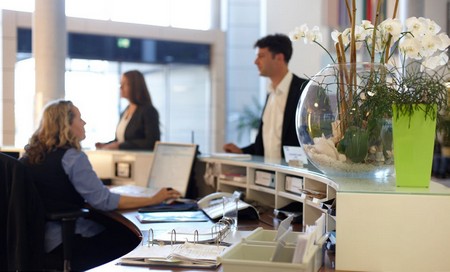Abschnitt 3.4 - 3.4 Reception areas
The reception area is the first point of contact with your company. It should make an attractive and inviting impression upon visitors. Your employees in this area are subject to particular stresses. For example, frequent opening and closing of the entrance door can give rise to draughts. This chapter contains information on setting up workplaces in your reception area.

 | Statutory references |
|---|---|
| |
 | Further information |
|---|---|
| |
 | Hazards |
|---|
In the majority of cases, workplaces in a company's reception area are equipped with VDUs. You should therefore consider the hazards described in Chapter 3.3 and implement the measures described there at these workplaces. Employees in your company's reception area may be exposed to the following further hazards:
Particular climatic conditions attributable to the design of the reception area (such as draughts through entrance doors; heat in the summer)
Unfavourable ambient factors (such as noise, room acoustics and lighting)
Slipping, falling and tripping, for example owing to damp or smooth floors
Mental stress (for example owing to social interaction with customers, verbal attacks, threats, emotional labour)
Physical stress caused by standing or sitting for long periods
 | Measures |
|---|
Set up your reception workplace such that office tasks can be performed sitting. Should your employees' tasks require them to spend longer periods in a standing position, provide them with suitable standing aids (standers).
If necessary, provide employees with adequate surfaces and temporary storage facilities for post, parcels and consignments to prevent such items from obstructing the free movement areas and circulation routes. Provide sufficient areas for any office equipment required at this workplace (such as franking machines).
When planning your reception area, ensure that it is also able to meet the climatic requirements for workplaces (for example: atmospheric temperature for seated tasks: 20-22 °C, maximum air velocity 0.15 m/s, see Chapter 3.2.2).
 Erection of a windbreak at the entrance reduces the influence of draughts at the reception workplace. In particular, should a large part of your reception area's façade be glazed, you can limit the rise in temperature by means of sun blinds or similar suitable measures.
Erection of a windbreak at the entrance reduces the influence of draughts at the reception workplace. In particular, should a large part of your reception area's façade be glazed, you can limit the rise in temperature by means of sun blinds or similar suitable measures.
Analyse the tasks performed by your employees in the reception area. These determine the permissible noise level. Should the tasks involve VDU work (primarily mental activity), the sound assessment level must not exceed 55 dB(A). During contact with customers, ensure that a value of 70 dB(A) is not exceeded (see Chapter 3.2.3).
 Construction materials (such as glass, natural stone floors, decorative concrete)
that have an unfavourable impact upon the room acoustics (a long reverberation time)
are frequently employed in reception areas. Acoustic sails, sound absorber panels
on walls and sound-absorbing furniture and furnishing elements can be used to create
favourable room acoustics in your reception area. This will also be appreciated by
your customers.
Construction materials (such as glass, natural stone floors, decorative concrete)
that have an unfavourable impact upon the room acoustics (a long reverberation time)
are frequently employed in reception areas. Acoustic sails, sound absorber panels
on walls and sound-absorbing furniture and furnishing elements can be used to create
favourable room acoustics in your reception area. This will also be appreciated by
your customers.
Ensure that a minimum illuminance of 500 lux is attained during VDU work in the reception area (see Chapter 3.2.1).
Have floor coverings with adequate slip resistance fitted in the reception area (see Chapter 3.2). Organize measures for the elimination of slipping hazards in the reception area caused for example by moisture or slush, and instruct your employees at reception in the measures you have put in place.
Ensure that your reception personnel possess all the information they need (for example expected guests, telephone lists, absent personnel) in order to complete their tasks (such as responding to customer enquiries).
Train your reception personnel in dealing with critical verbal scenarios.
Set out rules for behaviour and concrete measures for threatening situations (such as barring of persons from the premises, raising of alarms) and provide your reception staff with instruction regarding these measures.
